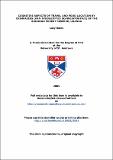Files in this item
Cognitive aspects of travel and food location by chimpanzees (Pan troglodytes schweinfurthii) of the Budongo Forest Reserve, Uganda
Item metadata
| dc.contributor.advisor | Byrne, Dick | |
| dc.contributor.author | Bates, Lucy | |
| dc.coverage.spatial | 255 | en_US |
| dc.date.accessioned | 2012-06-08T13:19:15Z | |
| dc.date.available | 2012-06-08T13:19:15Z | |
| dc.date.issued | 2005 | |
| dc.identifier.uri | https://hdl.handle.net/10023/2697 | |
| dc.description.abstract | Finding food in tropical forests poses a potentially major problem for chimpanzees, whose ranging is thought primarily to be directed at locating suitable food resources: (1) chimpanzees are frugivorous, large bodied and live in large home ranges; (2) they lack specialised sensory or locomotor abilities, and terrestrial travel is known to be costly; but (3) fruits are randomly distributed in space and time. Evidence from studies of captive individuals suggests chimpanzees are capable of remembering the locations of out of sight resources and can compute least distance routes to these resources, but whether this ability translates to the natural foraging behaviour of wild chimpanzees has never been investigated. My observational study was designed to assess how the chimpanzees (Pan troglodytes schweinfurthii) of Budongo Forest, Uganda, locate these patchy resources. I mapped the routes of 14 focal individuals over a 12-month period. I considered how these foraging routes were structured by breaking the path into segments of travel between resources. Consecutive segments of travel between resources were found not to be independent, but assembled into "super-segments" that take in a number of resources along one trajectory. These super-segments are not necessarily directed towards feeding resources, however: travel is not always food directed. Comparisons of actual chimpanzee routes with randomly generated simulations suggest most individuals do not attempt to minimise their travel distances. There is evidence to suggest energetically stressed individuals can remember the locations of recently visited food resources and return to these patches in order to minimise travel distances when necessary, but overall, food is not difficult to find for this community of chimpanzees. I propose this is because males defend a territory with super-abundant food resources, meaning availability is not a limiting factor of foraging. Male chimpanzees can be characterised as convenience feeders, taking food whilst satisfying other, social needs. | en_US |
| dc.language.iso | en | en_US |
| dc.publisher | University of St Andrews | |
| dc.subject.lcc | QL737.P96B2 | |
| dc.subject.lcsh | Chimpanzees--Behavior--Uganda--Budongo Forest Reserve | en_US |
| dc.subject.lcsh | Pan troglodytes--Behavior--Uganda--Budongo Forest Reserve | en_US |
| dc.subject.lcsh | Cognition in animals | en_US |
| dc.title | Cognitive aspects of travel and food location by chimpanzees (Pan troglodytes schweinfurthii) of the Budongo Forest Reserve, Uganda | en_US |
| dc.type | Thesis | en_US |
| dc.type.qualificationlevel | Doctoral | en_US |
| dc.type.qualificationname | PhD Doctor of Philosophy | en_US |
| dc.publisher.institution | The University of St Andrews | en_US |
This item appears in the following Collection(s)
Items in the St Andrews Research Repository are protected by copyright, with all rights reserved, unless otherwise indicated.

